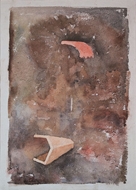![]() Traditional, Modern & Contemporary Indian Art
Traditional, Modern & Contemporary Indian Art
![]() Traditional, Modern & Contemporary Indian Art
V S GAITONDE (1924 - 2001)
Traditional, Modern & Contemporary Indian Art
V S GAITONDE (1924 - 2001)
RELATED LOTS
-
Provenance
 Provenance
Provenance
Acquired from an auction in Delhi, 2006
Important Private Collection, south-India
-
Literature
 Literature
Literature

"Everything starts from silence. The silence of the brush. The silence of the canvas. The silence of the painting knife." - V S Gaitonde (in an interview to Pritish Nandy, Illustrated Weekly of India, 7th - 13th September 1991)
V S Gaitonde's oeuvre is a study in contemplation. He was well-known to give himself over to the artistic process, claiming there was no room for thought while creating. Fiercely individualistic, he worked from a place of inner quietude, which comes abundantly across in his selected body of works (including the work here). This can be seen in the way he lived his life, as well.
Gaitonde hailed from Nagpur, where he was born in 1924. He attended the prestigious Sir J.J. School of Art in Mumbai in 1948. While he was initially a part of the modernist artist collective, the Progressive Artists Group populated by the likes of Husain and Souza, he was quite the outlier, going on to define his career in a more solitary fashion, gaining a reputation as a reclusive genius. In what reveals Gaitonde's obsession with his craft, his sister Kishori Das recollects how a girl he was in love with left him for someone else while he was abroad. "People talk about how he was always reclusive, but I think it was this particular incident that made him so It changed him, and he started keeping more to himself." - Kishori Das (as told by the artist's sister to journalist Mithila Phadke in Art Not Fame Mattered to Gaitonde, 22nd December 2013).
Now, he is eminently recognisable as an artist who has found exorbitant critical as well as commercial acclaim. A master of abstractionism, he worked in the realm of light and colour, eschewing the figurative and tending towards the non-objective. His works are full of vibrant hues and an almost overwhelming character, yet still somehow rooted in silence. Conversely here, though retaining the characteristic silence, in a stunning oil on paper executed circa 1958-59, the hues used are deep and powerful, freezing the viewer into stillness, which is the very state in which they were created. It is as once a study in expressionism as well as a fine example of the purity of painting as an art form. One could say that through his artwork, and this piece in particular, Gaitonde strips away the unnecessary in process, giving way to quiet truths of form and pigment.
-
Notes
 Notes
Notes

REFER: pl. 141, The Making of Modern Indian Art: The Progressives, Yashodhara Dalmia, Oxford University Press, 2001, work from the same series, in the collection of Tata Institute of Fundamental Research





